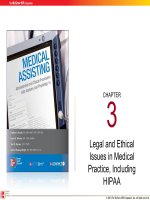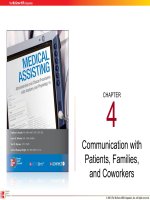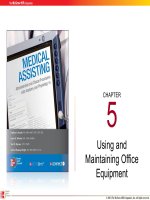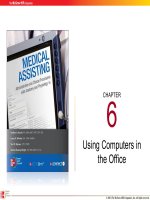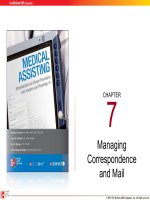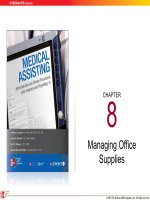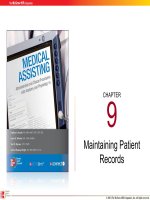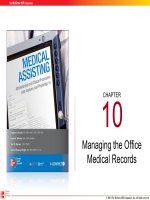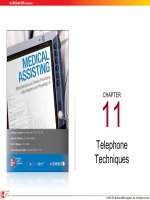Lecture Medical assisting: Administrative and clinical procedures with anatomy and physiology (4e) – Chapter 25
Bạn đang xem bản rút gọn của tài liệu. Xem và tải ngay bản đầy đủ của tài liệu tại đây (1.21 MB, 73 trang )
CHAPTER
25
The Nervous
System
© 2011 T he McGraw -Hill Com panie s, Inc. A ll rights reserv ed.
25-2
Learning Outcomes
25.1 Explain the difference between the central
nervous system and the peripheral nervous
system.
25.2 Describe the functions of the nervous
system.
25.3 Describe the structure of a neuron.
25.4 Describe the function of a nerve impulse and
how a nerve impulse is created.
© 2011 T he McGraw -Hill Com panie s, Inc. A ll rights reserv ed.
25-3
Learning Outcomes (cont.)
25.5 Describe the structure and function of a
synapse.
25.6 Describe the function of the blood-brain
barrier.
25.7 Describe the structure and functions of
meninges.
25.8 Describe the structure and functions of the
spinal cord.
© 2011 T he McGraw -Hill Com panie s, Inc. A ll rights reserv ed.
25-4
Learning Outcomes (cont.)
25.9 Describe the location and function of
cerebrospinal fluid.
25.10 Define reflex and list the parts of a reflex arc.
25.11 List the major divisions of the brain and give
the general functions of each.
25.12 Explain the functions of the cranial and
spinal nerves.
© 2011 T he McGraw -Hill Com panie s, Inc. A ll rights reserv ed.
25-5
Learning Outcomes (cont.)
25.13 Describe the differences between the
somatic nervous system and autonomic
nervous system.
25.14 Explain the two divisions of the autonomic
nervous system.
25.15 Describe the causes, signs and symptoms,
and treatments of various diseases and
disorders of the nervous system.
© 2011 T he McGraw -Hill Com panie s, Inc. A ll rights reserv ed.
25-6
Introduction
•
Highly complex
system of two parts
– Central nervous
system (CNS)
– Peripheral nervous
system (PNS)
•
Controls all other
organ systems and is
important for
maintaining balance
within those systems
Disorders
Disorders are
are numerous
numerous and
and often
often
difficult
difficult to
to diagnose
diagnose and
and treat
treat
© 2011 T he McGraw -Hill Com panie s, Inc. A ll rights reserv ed.
25-7
General Functions of the NS
• CNS
– Brain
– Spinal cord
• PNS
– Peripheral nerves
– Two sections
• Somatic nervous
system (SNS)
– Skeletal or
voluntary
muscles
• Autonomic
nervous system
(ANS)
– Automatic
functions
© 2011 T he McGraw -Hill Com panie s, Inc. A ll rights reserv ed.
25-8
General Functions (cont.)
• Three types of neurons
– Afferent or sensory nerves
•
Sensory information from environment or inside body to CNS for interpretation
– Efferent or motor nerves
•
Impulses from CNS to PNS to allow for movement or action
– Interneurons
•
Interpretive neurons between afferent and efferent nerves in the CNS
© 2011 T he McGraw -Hill Com panie s, Inc. A ll rights reserv ed.
25-9
Apply Your Knowledge
Match the following:
ANSWER:
B Somatic nervous system
___
A. Motor nerves
C Autonomic nervous system B. Governs skeletal or voluntary
___
muscles
A Afferent nerves
___
systems
E
C. Governs respiratory and GI
___
D Efferent nerves
___ Interneurons
D. Go-betweens or interpreters
E. Sensory nerves
© 2011 T he McGraw -Hill Com panie s, Inc. A ll rights reserv ed.
25-10
Neuron Structure
•
Functional cells of
NS
•
Transmit
electrochemical
messages called
nerve impulses to
– Other neurons
– Effectors (muscles
or glands)
© 2011 T he McGraw -Hill Com panie s, Inc. A ll rights reserv ed.
25-11
Neuron Structure (cont.)
•
Neurons lose their ability to divide
– If destroyed, not replaced
•
Neuralgia
– Support cells for neurons that can divide
– Astrocytes – anchor blood vessels to nerves
– Microglia – act as phagocytes
– Oligodendrocytes – assist with production of myelin
sheath
© 2011 T he McGraw -Hill Com panie s, Inc. A ll rights reserv ed.
25-12
Neuron Structure (cont.)
Neurons
Neurons have
have aa cell
cell
body
body and
and processes
processes
called
called nerve
nerve fibers
fibers that
that
extend
extend from
from the
the cell
cell
body.
body.
Dendrites – short
Receive nerve impulses
for the neuron
Axons – long
Send nerve impulses
away from the cell body
© 2011 T he McGraw -Hill Com panie s, Inc. A ll rights reserv ed.
25-13
Neuron Structure (cont.)
• White matter – axons
with myelin sheath
Dendrites
Schwann
cells
Axon
– Schwann cells
• Wrap around some
axons
• Cell membranes
contain myelin
• Myelin insulates axons
and enables axons to
send nerve impulses
more quickly
• Gray matter – axons
without myelin sheath
© 2011 T he McGraw -Hill Com panie s, Inc. A ll rights reserv ed.
25-14
Apply Your Knowledge
True or False:
ANSWER:
___
F Effectors are neurons.
They are the muscles or glands.
F Neurons can reproduce.
___
Neurons cannot reproduce.
T Astrocytes anchor blood vessels to nerve cells.
___
T Microglia act as phagocytes.
___
F
___
Oligodendrocytes are reproductive cells.
They take part in
myelin production.
T Repolarization is the return to the resting state.
___
GOOD JOB!
© 2011 T he McGraw -Hill Com panie s, Inc. A ll rights reserv ed.
25-15
Nerve Impulse
•
Membrane potential
– Neuron cell membrane at rest is in a polarized state
•
•
Inside of cell membrane is negative
Outside of cell membrane is positive due to more Na + and K+
– As Na+ and K+ move into the cell, the membrane
becomes depolarized
•
•
Inside becomes more positive
Action potential (nerve impulse) is created
– Repolarization occurs when K+ and later Na+ move to
the outside of the cell membrane
•
Return of the cell to polarized (resting) state
© 2011 T he McGraw -Hill Com panie s, Inc. A ll rights reserv ed.
25-16
Nerve Impulse (cont.)
•
Impulse travels down axon to synaptic knob
– Vesicles or small sacs in synaptic knob
•
Produce chemicals called neurotransmitters
– Neurotransmitters are released by synaptic knob
•
Allow impulse transmission to postsynaptic structures
– Dendrites
– Cell bodies
– Axons of other neurons
© 2011 T he McGraw -Hill Com panie s, Inc. A ll rights reserv ed.
25-17
Nerve Impulse (cont.)
•
Functions of neurotransmitters
– Cause muscles to contract or relax
– Cause glands to secrete products
– Activate or inhibit neurons
© 2011 T he McGraw -Hill Com panie s, Inc. A ll rights reserv ed.
25-18
Apply Your Knowledge
What is the function of neurotransmitters?
ANSWER: Neurotransmitters cause muscles to
contract or relax, cause glands to secret products,
activate neurons to send nerve impulses, or inhibit
neurons from sending them.
Right
© 2011 T he McGraw -Hill Com panie s, Inc. A ll rights reserv ed.
25-19
Central Nervous System
•
•
Includes the spinal cord and brain
Blood-brain barrier
– Protects layers of the membranes of the
CNS
– Formed by tight capillaries
•
Prevents unwanted substances from entering the CNS tissues
•
Inflammation can make more permeable
© 2011 T he McGraw -Hill Com panie s, Inc. A ll rights reserv ed.
25-20
Central Nervous System (cont.)
•
Meninges –protect brain and spinal cord
– Dura mater
•
Tough outer layer
– Arachnoid mater
•
Middle layer (web-like)
– Pia mater
•
Innermost and most
delicate
•
Directly on top of brain
and spinal cord
•
Holds blood vessels on the
surface of these structures
© 2011 T he McGraw -Hill Com panie s, Inc. A ll rights reserv ed.
25-21
Central Nervous System (cont.)
– Epidural space
•
Above dura mater
– Subdural space
•
Below dura mater
– Subarachnoid space
•
Between arachnoid mater and pia mater
•
Contains cerebrospinal fluid (CSF)
•
Cushions CNS
© 2011 T he McGraw -Hill Com panie s, Inc. A ll rights reserv ed.
25-22
Spinal Cord
•
Slender structure continuous with
the brain
•
Descends into the vertebral canal
and ends around the level of the
first or second lumbar vertebra
•
31 spinal segments:
–
–
–
–
–
8 cervical segments
12 thoracic segments
5 lumbar segments
5 sacral segments
1 coccygeal segment
© 2011 T he McGraw -Hill Com panie s, Inc. A ll rights reserv ed.
25-23
Spinal Cord (cont.)
© 2011 T he McGraw -Hill Com panie s, Inc. A ll rights reserv ed.
25-24
Spinal Cord (cont.)
•
Gray matter
– Inner tissue with darker color
– Contains neuron cell bodies and their
dendrites
– Divisions are called horns
– Central canal runs down the entire length
of the spinal cord through
Spinal
Cord/Nerve
the center of the gray matter
© 2011 T he McGraw -Hill Com panie s, Inc. A ll rights reserv ed.
25-25
Spinal Cord (cont.)
•
White matter
– Outer tissue
– Contains myelinated axons
– Divisions are called columns (funiculi)
•
Columns contain groups of axons called
nerve tracts
Spinal
Cord/Nerve
© 2011 T he McGraw -Hill Com panie s, Inc. A ll rights reserv ed.

